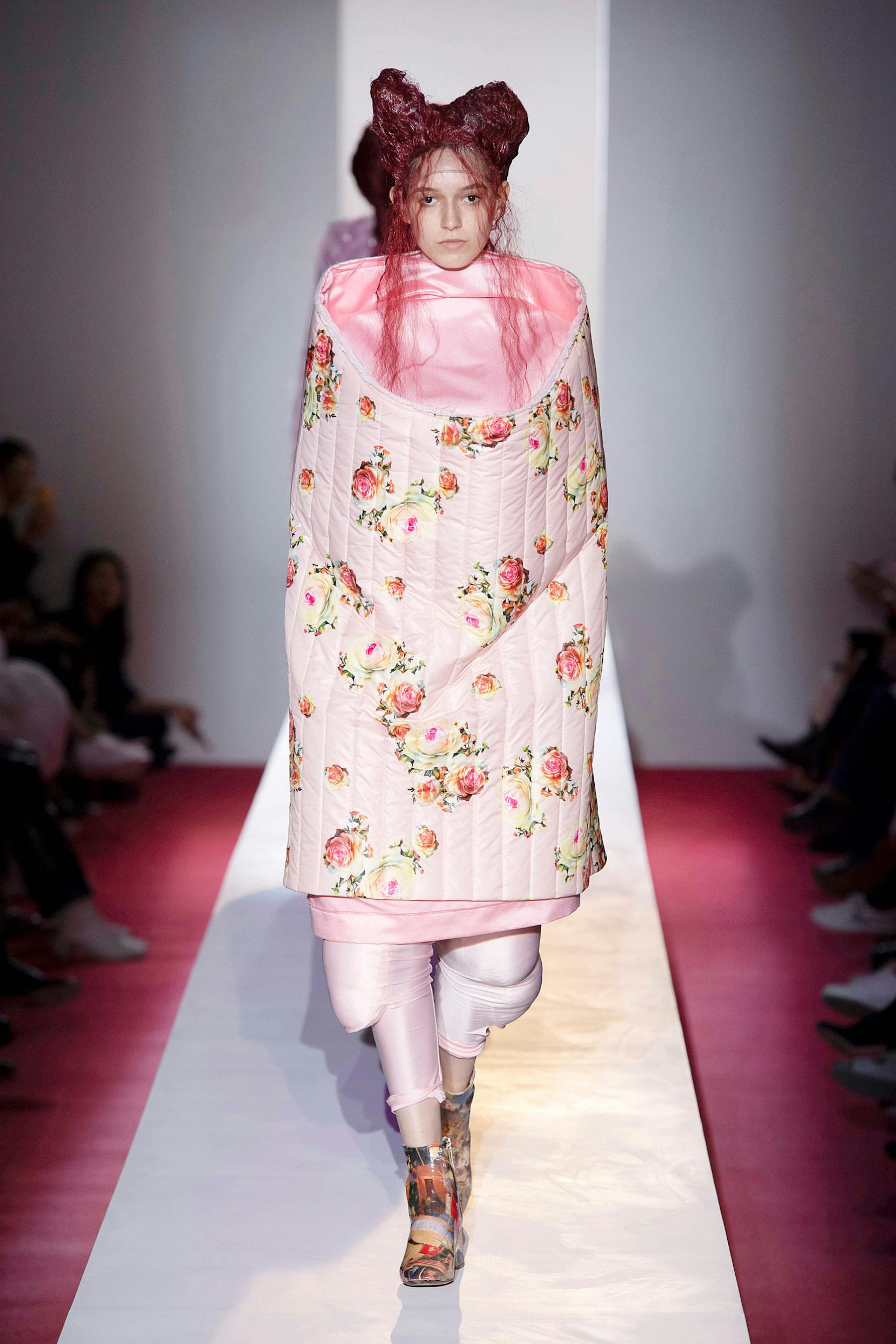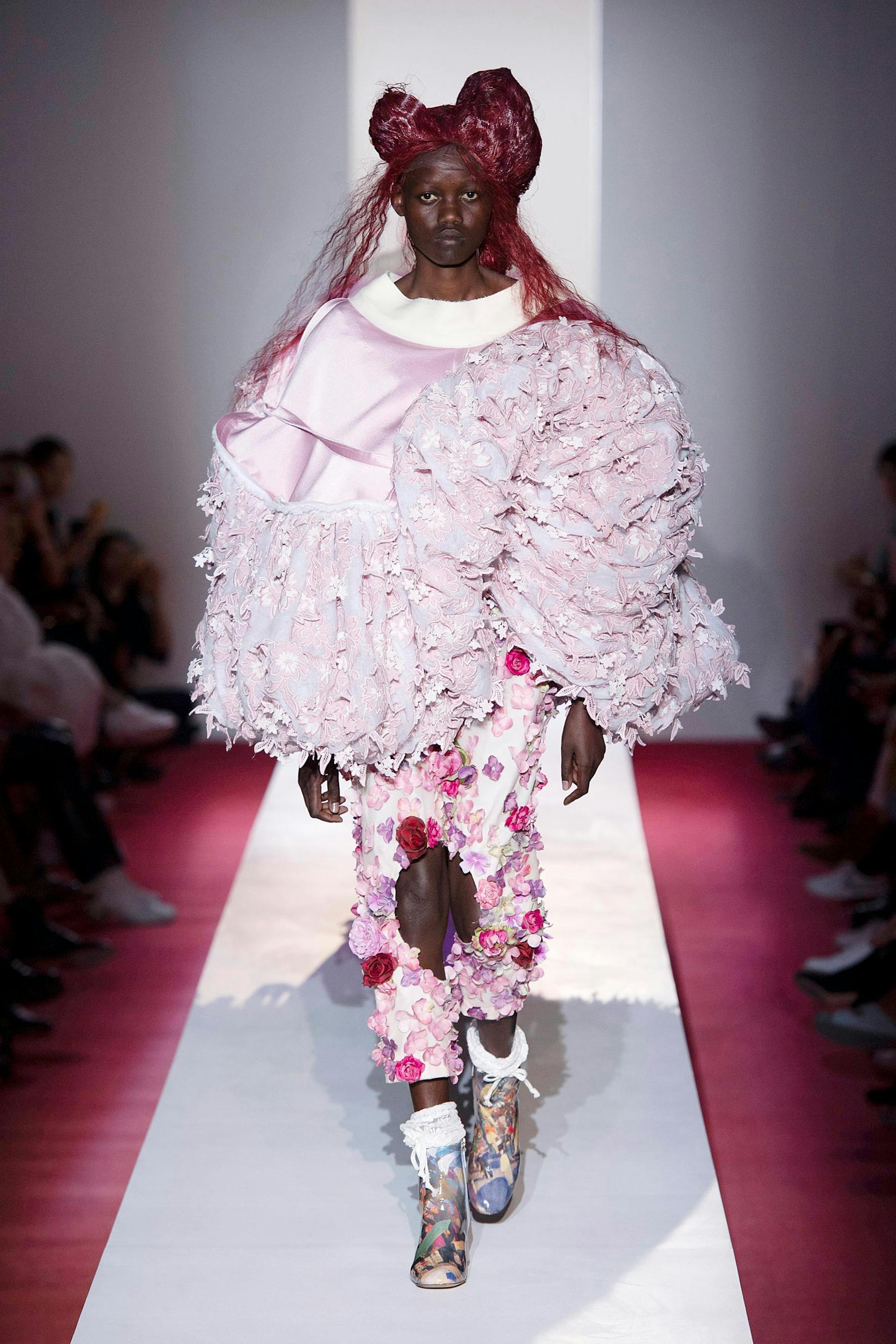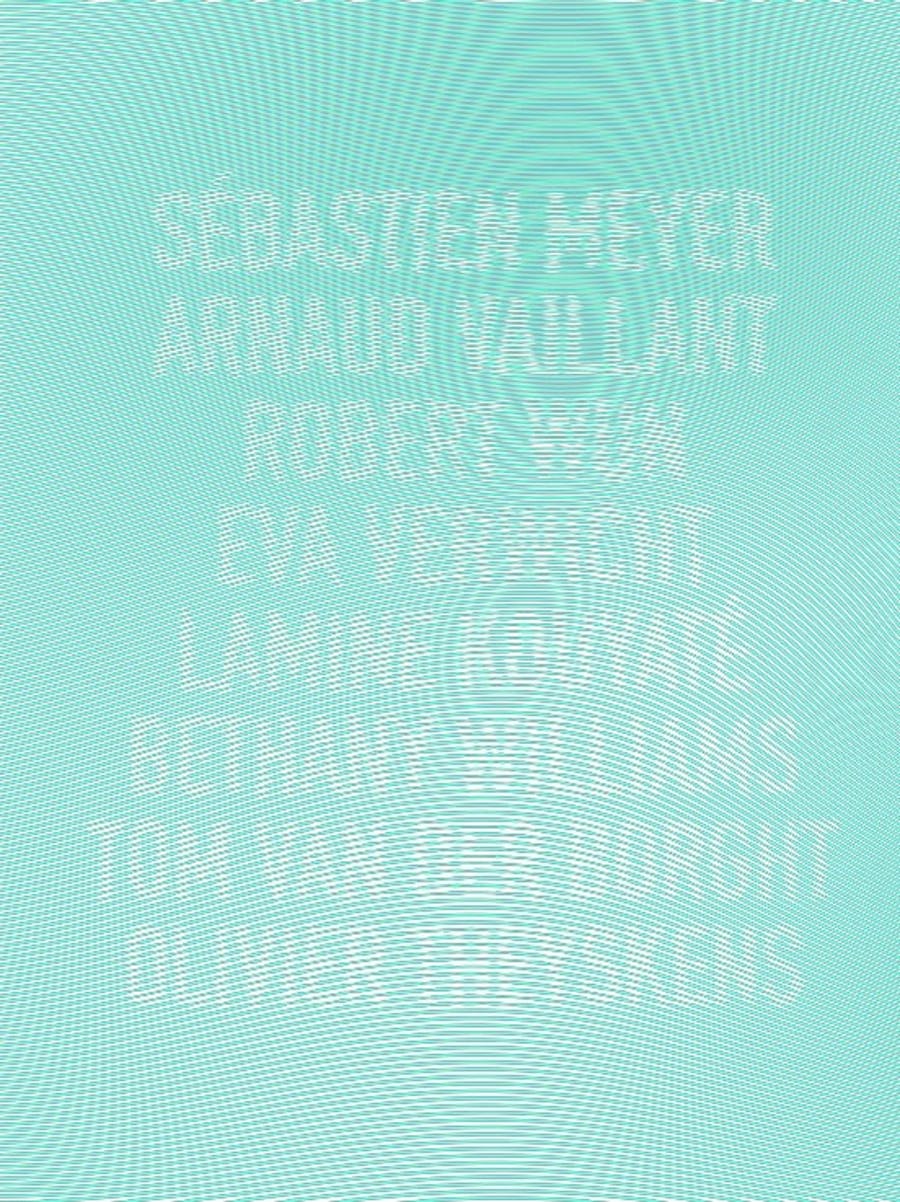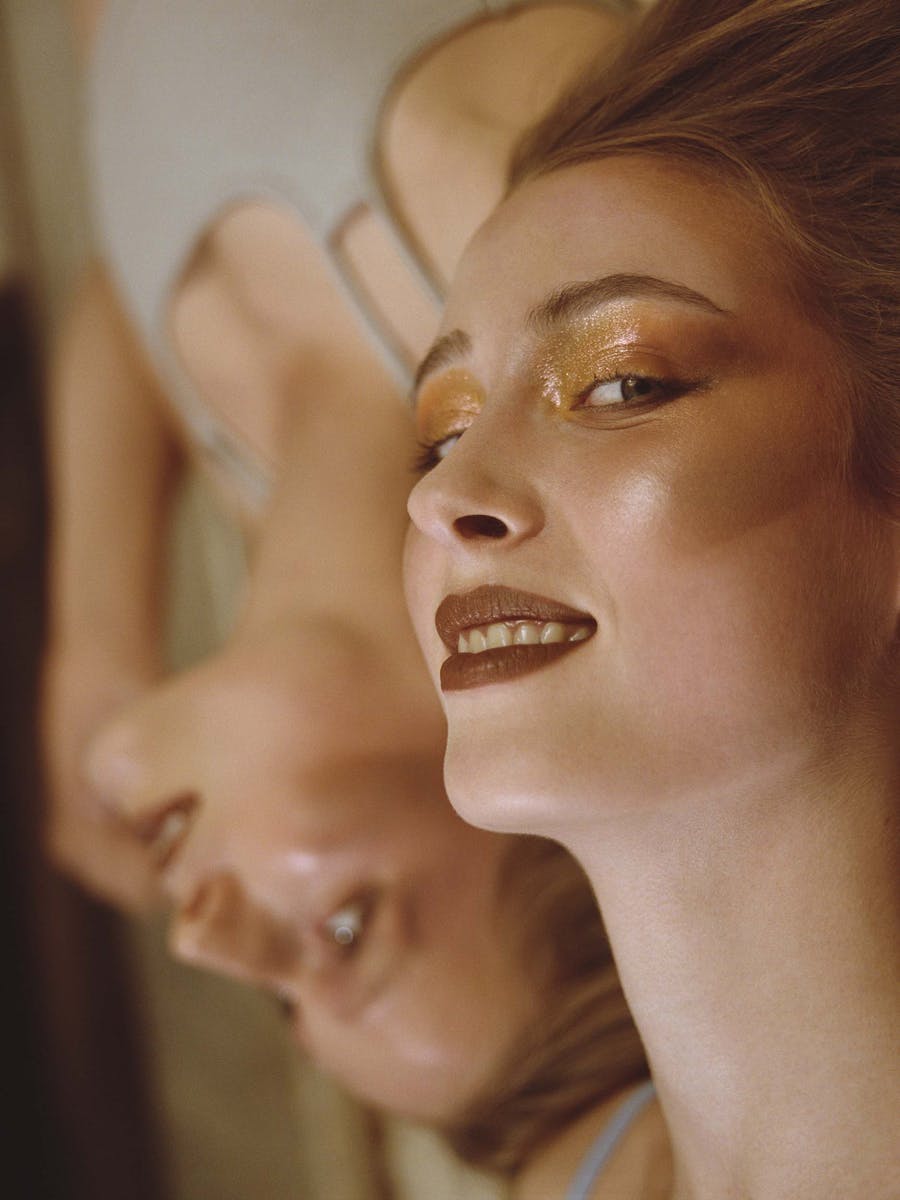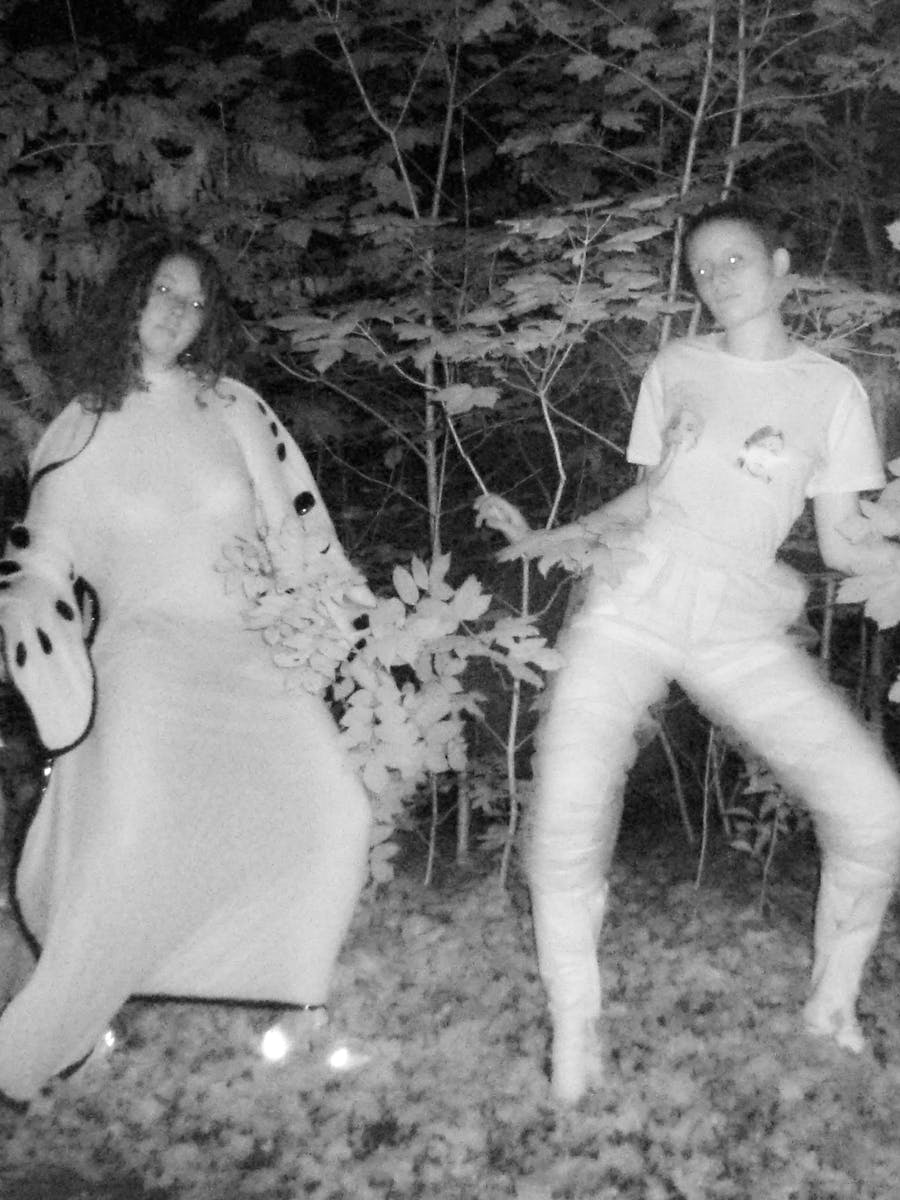at the London College of Fashion
at the Parsons School of Design in New York
at the University of Applied Arts in Vienna
Deconstruction is the bearer of a multivocal imaginary, which would itself have to be deconstructed to extract a substance. But that very gesture, by inviting us to trace an intellectual history, to choose our words and establish a timeline, would render deconstructivist thought – which we always think of as liquid – almost palpable, thus betraying it…the trickster tricked?
So, let’s just say that there was Jacques Derrida, and a conference in Baltimore in 1966, then Jean-François Lyotard, and then followed the success of French Theory in America, the identification and the critique of a postmodern philosophy, deconstructivism in architecture and art… And where does fashion fit in in all of that? As a phenomenon it is the best possible metaphor for deconstruction. It mixes and recycles a limited repertoire of signs, which constantly appear new in their assemblage. Fashion destroys trends and renews them: it has neither beginning nor end. It is also a space in which imaginary identities take shape, in which stereotypes crystallize. It is up to the actors in the fashion industry to deconstruct them or to cement them. Every swing of the axe or rumble of the cement-mixer speaks to us, both of the spirit of the age and of the role of fashion in society. What subjects are being deconstructed by today’s fashion? For Exhibition, the researchers Pierre-Antoine Chardel, Caroline Stevenson, Francesca Granata and Monica Titton analyse four deconstructed looks by Comme des Garçons and Louis Vuitton. Even typing these words, that speak of an encounter between a researcher and a set of clothes, is itself an act of deconstruction.
SILHOUETTE N°8 BY PIERRE-ANTOINE CHARDEL
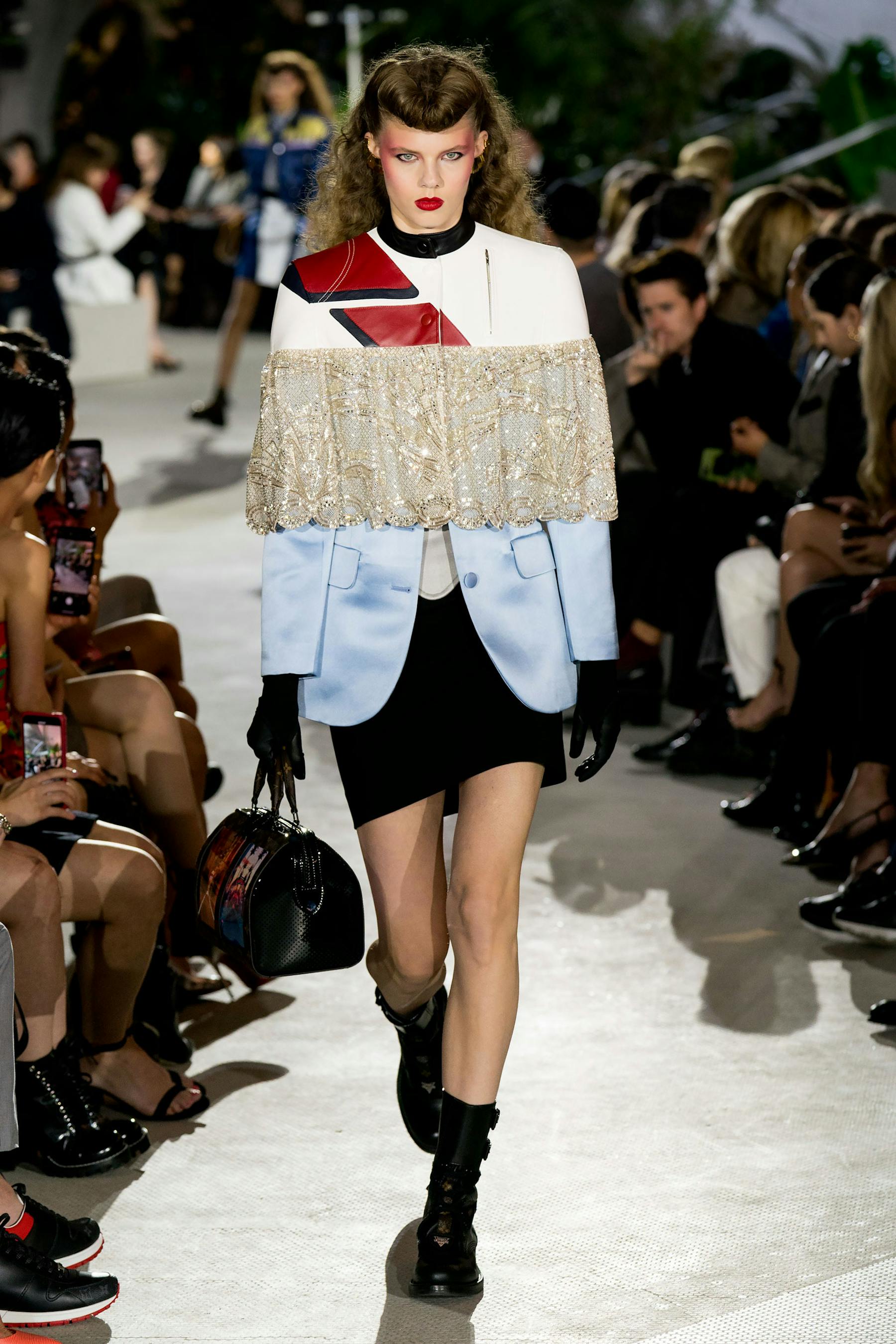
Cruise Collection 2020 LOUIS VUITTON
Louis Vuitton – Cruise Collection 2020
In May 2020 Nicolas Ghesquière will take over the TWA Flight Centre of JFK airport to present the Louis Vuitton cruise collection. Opened in 1962, the terminal designed by the architect Eero Saarinen has been closed to visitors since 2001. It is a place of ghosts and memories, but also a site of transit, and therefore an appropriate venue to present an aesthetic in which the body is always on the point of leaving.
“In the major fashion houses, fashion is always a game in which codes are transgressed. Fashion is, and remains, a space that is future-oriented, a space of emancipation and liberation – that is what distinguishes it from mass consumption. Luxury operates in the articulation between an exploratory space for the individual and representations grounded in a sense of history and accumulated expertise. Fashion is simultaneously about projecting the individual and guaranteeing a fixed identity,” explains the philosopher Pierre-Antoine Chardel, whose research focuses on the development of processes of subjectivation in societies considered hypermodern. ‘For years, Louis Vuitton has established codes which then become the object of decodings, in other words they are appropriated by those who buy but also those who look. Thus, the creative director [Ed’s note: Nicolas Ghesquière] juggles with established codes and decodings, which rely on more than singularity, always keeping the cards in play. If we decode this outfit by examining it from head to toe, we notice that the upper part evokes competition, speed, effort. The second part adds a note of elegance which we might expect in evening wear. The final, most austere part would be appropriate in a professional situation. Beyond any subjective decodings, what seems to be going on here is a multiplication of identity. Fragmentation, dispersal: the individual refuses to be identified and assumes a multiplicity of selves.
The model continues her sovereign progress, passing beyond the gazes of the spectators who try to detain her – or at least her image – with their mobile phones. This way of resisting identification, at a time when facial recognition has become a political issue, may remind us of a text by Maurice Blanchot entitled ‘The Terror of Identification’, in which he explores how the individual defines themselves through their capacity to play with different identities – a capacity to appear and rename oneself in multiple ways. We might also consider a Nietzschean way of thinking of the individual as a totality of effects which are not reducible to a unitary ‘I’. To say ‘I’ is a grammatical illusion: unity is a fantasy. Liberation at the level of the imaginary means not letting the individual confine themselves to a single mode of appearing. Which is important for the universe of fashion, isn’t it? Thus, here, the body in movement in this image, voluntarily disparate, invokes an assumed multiplicity. It is an ode, a show of resistance to unity, which has its noble origins in Greek mythology, if we think of Ovid’s Metamorphoses for example, or the figure of Dionysus. But our era is complex, as a result of the alliance between the fantasy of an ‘I’ and that of the plural grammaticality of the individual visible on social media.
The choice of place is significant: the airport is an example of what Marc Augé calls non-places. In using it, Vuitton reinvests it with meaning, turning it into a place of Vuitton. In our societies, the airport has become a site of transit, but also of permanent identification (via biometric technology and facial recognition), where suspicion is pervasive. It is a place where identities are sorted, where the ‘good tourist’ is separated from the ‘bad tourist’…Now, in this image, identity is troubled. Is the Vuitton woman suspicious? In any case, the screen on her bag acts as a shield. Culturally, the bag is a subjective, private space which encloses a multitude of secrets and personal data. And here it is, furnished with a screen, becoming the incarnation of what Gilles Lipovetsky calls a ‘self-media’ – a media on the basis of which the individual can form a more subjective relationship with information and with the world. In the scene we are witnessing at this show, the bag will act as the possibility of turning surveillance against itself. At the moment when it rolls through the security check, the bag will immediately sound the alarm… The power of this screen doubtless lies in its ability to screen us temporarily from those of surveillance.”
Pierre-Antoine Chardel is a philosopher and sociologist, a specialist in the ethical issues surrounding digital culture and hypermodernity.
De l’écrit aux écrans. Pour une sociologie herméneutique du temps présent, Paris, CNRS Editions, forthcoming.
SILHOUETTE N°2 BY CAROLINE STEVENSON
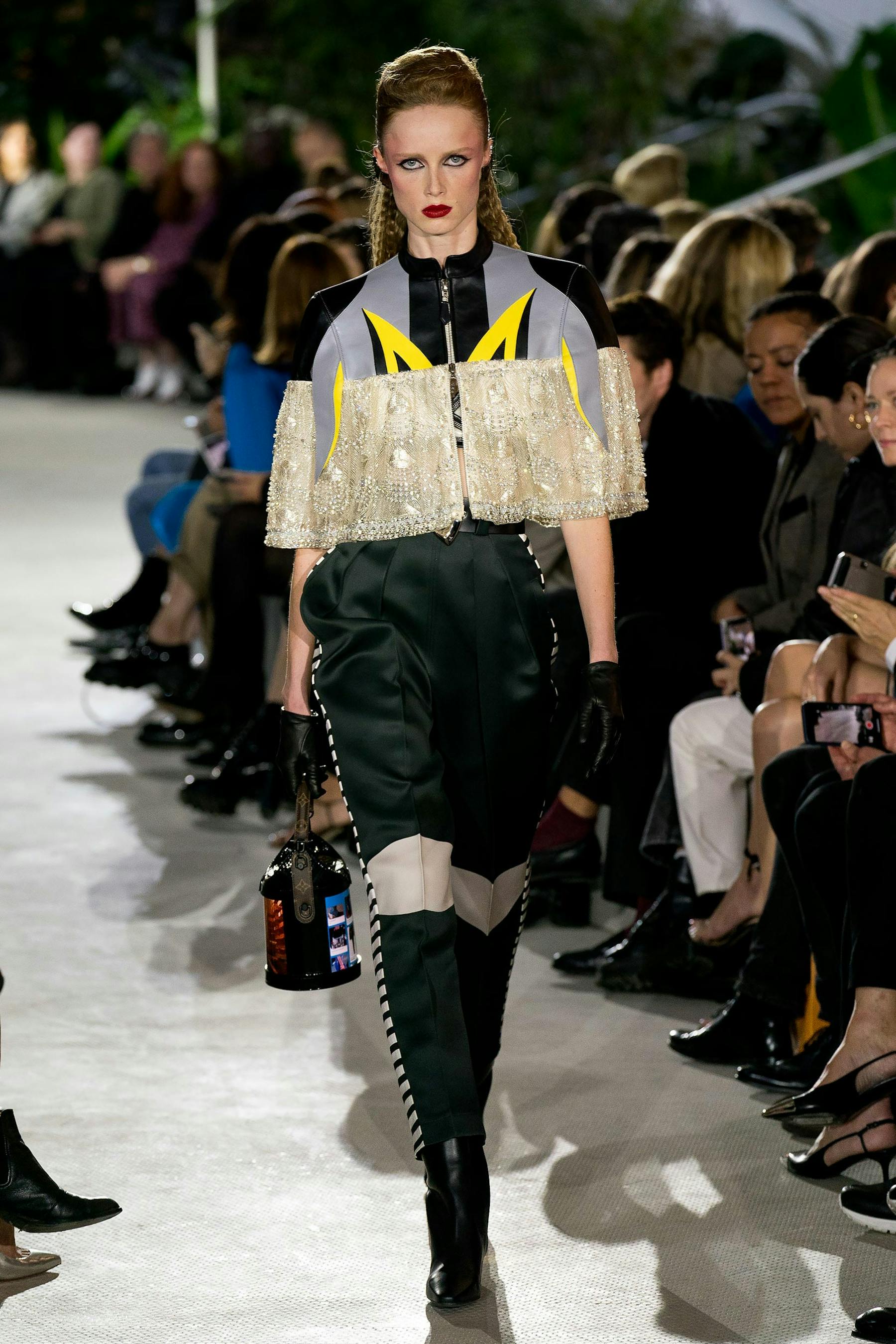
Cruise Collection 2020 LOUIS VUITTON
"I find myself face to face with this flat image of a three-dimensional outfit. The lines are geometric, angular – an element of 80s style is discernible. The more one looks at the image, the more obvious it becomes that fashion is not simply the material object in three dimensions, but it also offers the opportunity to create a poetics of the image-making aspect of clothing mediated by the fixed image of a picture that seems to be living. Genius here lies in the possibility of creating an image of movement, of speed, through a flat, fixed image, in the manner of Picasso,” the researcher and curator Caroline Stevenson tells us. The way she talks about the fashion “image” emphasizes its proximity to a kinetic art founded on an aesthetic of movement in which heterogeneous, even dissonant elements are contained by a force which both eludes and fascinates us. For Stevenson, there is a metaphor here that expresses more broadly what is at stake in the creation of ’material’ fashion. The author of several texts on art and design, she is interested in the links between words and images, within the artistic collective Modus, which she recently founded, a project which aims to create a bridge between the theory of fashion and its practice.
If Vuitton’s watchword is travel, it is perfectly illustrated here: “The fashion image is a permanent journey between a show – a happening in 3D, which brings together in one place spectators and models who are stylized and dressed – and the image that remains, which is now just a collage in which different elements are assembled on a flat surface that, here, create the illusion of movement. Fashion is a three-dimensional object which evolves in space, but it must also function as an image to be shared and copied – especially on social media. The name of the game is articulating movement in material space and in immaterial space, where the item of clothing is no longer anything more than a flat image. So all the poetry emerges through the way in which things are placed. And here the game can be interpreted as a parataxis. In linguistics, that means juxtaposing clauses without using co-ordinating conjunctions. ’It was cold, it snowed.’ This image offers itself as a series of leaps in which no continuity is established. The parataxis maintains each element within a whole which becomes shocking or poetic. If we take a moment to consider the look as a whole, before examining each part, there is no a priori relationship between them – bright lace, deep green trousers with yokes at the knees. Its genius lies in preserving these tensions, and thus inviting the spectator to pause, provoking an emotion at a point in time when images circulate at the speed of light.
The image is a site of transit: the presence of the screen on the handbag stages that transit, from the 3D world to the flat world of the screen. It is in that in-between that fashion is caught, especially these days when everyday experiences are mediated through the world of images. Fashion has understood this age of mediatisation, and thus stylizes its image-clothes as much as its textile-clothes to create moments where time slows down. Faced with this image, I stop, I enlarge the image, I take it apart, I put it back together again. It is made to be looked at closely, so that each constituent element becomes an autonomous mini-composition. The flat image, full of geometric lines, is an eminently poetic collage which invites us to one particular experience: wearing the clothes.”
Caroline Stevenson is the head of the Department of Cultural and Historical Studies at the London College of Fashion.
Caroline Stevenson, Fashioning the Contemporary Artist: The Spatial Biography of Sue Tompkins, in: Fashioning Professionals: Identity and Self Representation at Work, Bloomsbury, 2018.
THE SILHOUETTE N°12 SEEN BY FRANCESCA GRANATA
Comme des Garçons – Spring-Summer 2020
Last September, Rei Kawakubo presented her Comme des Garçons womenswear collection, called “Orlando, transformation and liberation across time”, a reference to the eponymous protagonist of Virginia Woolf’s novel – who will also feature heavily at the next Met Gala. In 2017, Kawakubo herself was the guest of honour at the Met Gala. It was the perfect opportunity to look back over a career which has continuously explored and brought into focus the antagonisms which structure modern society.
“In 1981, in Kawakubo’s earliest shows, the cocoon dress was already there, as it is here. Almost a sleeping bag, it evokes protection. The woman turns her body into a safe place, redefining the idea of feminine domesticity traditionally imposed – a recurrent trope throughout Kawakubo’s career. At the time, that kind of silhouette was exceptional in the landscape of haute couture, where women wore dresses with very angular lines in fabrics such as velvet and silk, expressing luxury and opulence. Kawakubo and Yohji Yamamoto changed the fashion order. The 1997 Comme des Garçons show, called ’Bumps and Lumps’, presented female bodies deformed with ’grotesque’ protuberances, swathed in gingham, recalling childhood, whilst evoking maternity, the body, pregnancy. The pads were on the models’ backs and hips as well as their shoulders. It is interesting to note that here they appear on the legs. Indeed, that creates a wider, heavier silhouette. It calls into question ideals of the female body: in the 1980s, there were top models with unattainable measurements. Today, the ideal of the toned and perfected body has other measurements, other names. Kim Kardashian is selling her ’shapewear’. Even if her body type is not that of a tall Caucasian blonde, it is nonetheless equally unattainable. We’re also living through a period in which plastic surgery techniques are becoming more sophisticated and in which physical exercise, in the context of the fitness empire, is becoming a must. At the same time, never before has there been so much talk of inclusivity, diversity, and body positivity. Questions of gender, the corporeal canon, remain, but the battle lines have shifted and are taking new ’forms’.
In the 1980s, everyone was obsessed with demolishing divisions between men and women. In that configuration, women armed with ’power-suits’ were taking the place of men. Their suits were based on the skirt to make the whole thing acceptable. Today the context is different, there are different boundaries to be broken, different kinds of subversion are necessary. The French writer Julia Kristeva uses two concepts: ’subject in process’ and ’pure self’. The first corresponds to a permanent state of ’becoming’, more than to a fixed and congealed identity – the pure state which we find in the modern Enlightenment ideal. The ’subject in process’ embraces alterity. Since 1997, the cards of alterity have been re-dealt, and on social media individuals find themselves faced with altered versions of their own images, reflected back to them as in a funhouse mirror. Social media is now part of the body – which gives rise to new protuberances.’
Francesca Granata est professeure de Fashion Studies à la Parsons School of Design à New York.
Francesca Granata, Experimental Fashion: Performance Art, Carnival and the Grotesque Body, I.B. Tauris, 2017.
SILHOUETTE N°16 SEEN BY MONICA TITTON
Why should we even try and dissect what makes Rei Kawakubo’s design particularly Japanese, given that we don’t do the same thing for American, British, French or Italian designers. Last year, at a conference on the history of fashion focused on the specificities of the traditional Japanese aesthetic, I discussed Kawakubo’s work and a student (who was Japanese) pulled me up on that, explaining that he was tired of hearing Europeans invariably approach the work of Japanese designers through the prism of nationality.” Monica Titton’s recent work has concentrated on the construction of the self and the other in fashion images through the post-colonial lens. (Post-colonial studies invaded the other side of the pond in the 1990s. The key question is whether we are living in a ’post-colonial’ world, that is to say a world liberated, politically, economically and culturally, from colonial forms of domination and their various avatars, but nonetheless still strongly marked by that period of domination.) In her book, Fashion and Postcolonial Critique, co-written with Elke Gaugele, she analyses fashion as a cultural, historical, social and political phenomenon affected by processes of decolonization and globalization.
In the 1980s, the arrival on the Parisian fashion scene of Japanese designers such as Issey Miyake, Kenzo Takada and Yohji Yamamoto brought into focus the issue of alterity in a fashion whose history had been written from a European perspective. “A voluminous pink silk top augmented with lace fringing, combined with trousers with appliqué flowers: visually there is a lot going on here, both in terms of the silhouette and the style. It is an appeal to the eye. The shoes decorated with petals continue the theme, responding to the collective imagination of women’s spring-summer collections. Here the cliché of spring flowers is parodied.
The model’s wig in the shape of a knot only accentuates the grotesque feeling of the ensemble as a whole. This look perfectly sums up why
Rei Kawakubo should be considered a feminist icon: through experiments with cut, form, silhouette, material and style, she makes timely political statements about what it means to be a woman and encourages us to rethink the female body and our perceptions of beauty. In other words, Kawakubo’s deconstruction of fashion invites us to be more conscious of the ways in which notions of femininity are constructed.
The decolonization of fashion aims at revealing the structures of colonial and neocolonial domination which continue to influence this industry today. Part of this process consists in underlining the predominance of tall, thin, white models on the catwalk. Naomi Campbell, Iman or Bethan Hardison are examples of black women who, from very early on, campaigned for more representation of black and Asian women on magazine covers and catwalks. Diversity amongst models remains an important question because they incarnate ideals of beauty. Adherence to white euro-American norms has had, and continues to have, devastating effects on women of colour and perpetuates models of colonial domination. Kawakubo has continued to redesign the contours of the female body, parodying any ideal. Today, interest in the political and social dimensions of fashion is growing.
The new generation of designers is more conscious of the omnipresence and the power of collective imaginaries. A process which enriches fashion and culture in general.”
Monica Titton is a sociologist and fashion theorist. She works at the University of Applied Arts in Vienna, where she teaches fashion history.
Elke Gaugele, Monica Titton (Eds.), Fashion and Postcolonial Critique, Sternberg Press, 2019.
Translated into English by Sara & Emma Bielecki.
at the London College of Fashion
at the Parsons School of Design in New York
at the University of Applied Arts in Vienna

